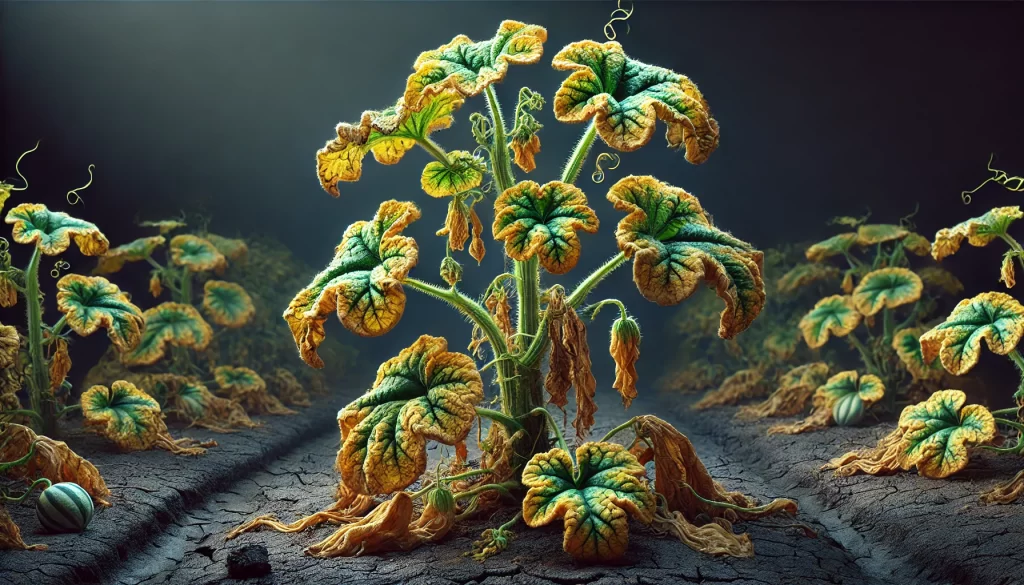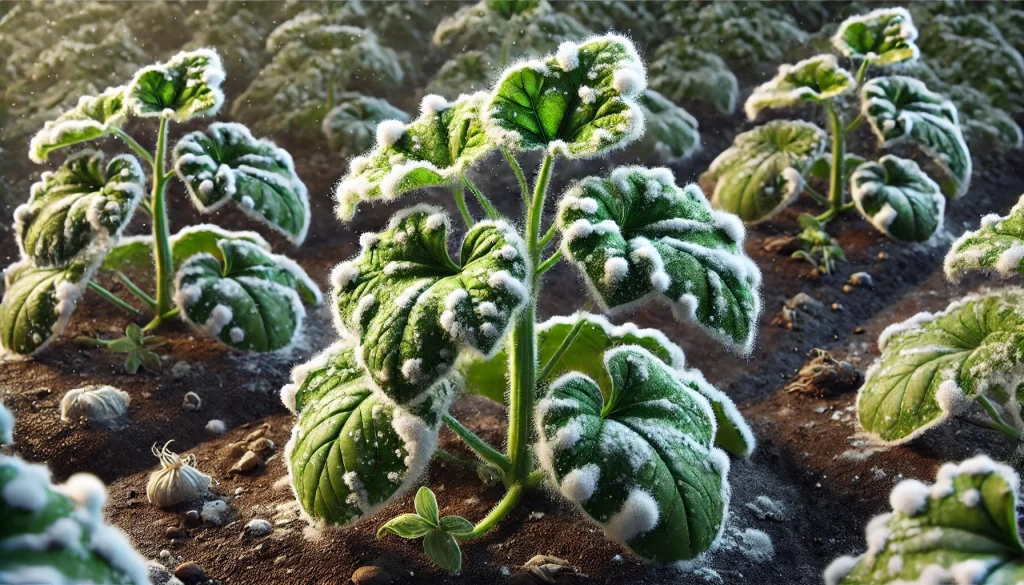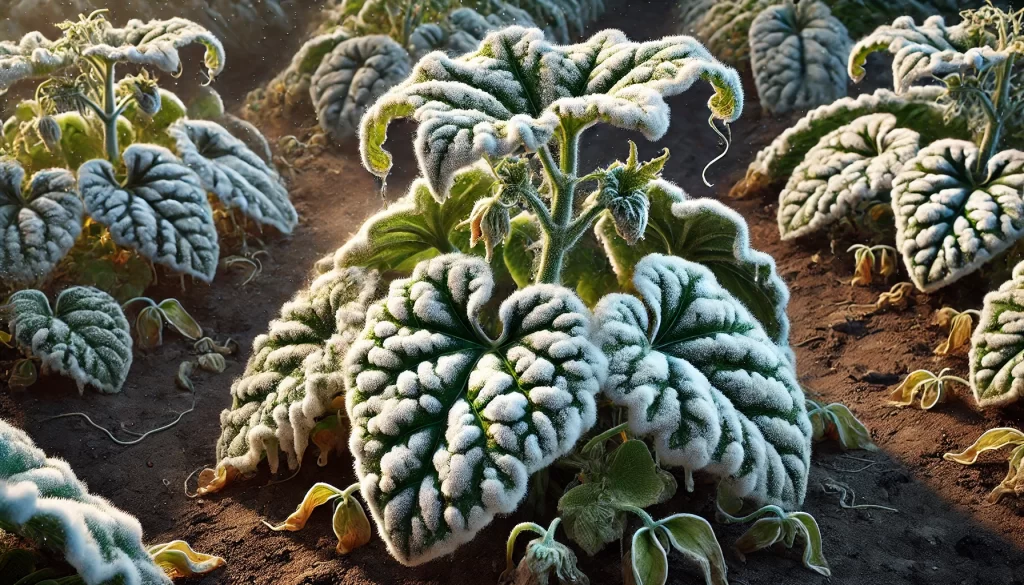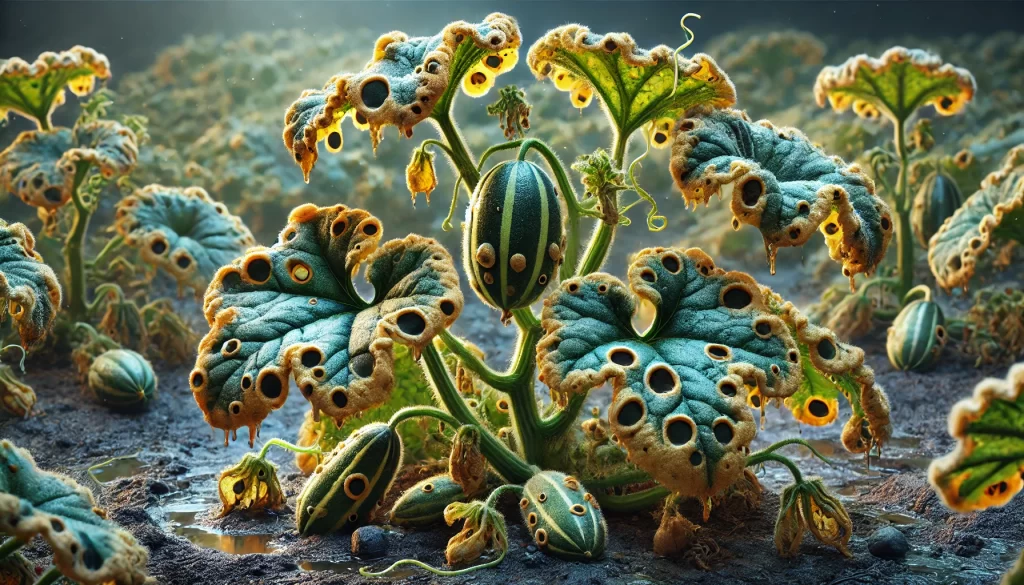The melon crop is exposed to various diseases that can affect both plant health and the quality and quantity of the harvest. Identifying these diseases, recognizing their symptoms, and adopting effective preventive and control measures are key steps in maintaining a healthy and profitable crop. In this article, we address the most common diseases that affect melon and offer strategies for their prevention and management.
Main Diseases of Melon
Fusarium Wilt (Fusarium oxysporum f. sp. melonis)

Symptoms:
- Younger leaves wilt and lower leaves yellowing.
- Brown discoloration in the stem’s vascular tissue.
- Progressive death of the plant.
Prevention and Control:
- Use of resistant varieties: Choose cultivars known to be resistant to Fusarium.
- Crop rotation: Avoid planting melon in the same location for multiple years to reduce pathogen presence in the soil.
- Water management: Avoid excess moisture that favors the spread of the fungus.
- Soil solarization: Use heat treatment to reduce spore populations.
Powdery Mildew (Sphaerotheca fuliginea)

Symptoms:
- White powdery growth on the surface of leaves, stems, and fruits.
- Deformed leaves and premature foliage drop.
- Reduced vigor and yield of the crop.
Prevention and Control:
- Synthetic and protective fungicides: Apply specific fungicides when the first signs are detected.
- Improve air circulation: Prune and space plants to reduce humidity around them.
- Remove infected debris: Remove infected leaves and fruits to prevent further spread.
Powdery Mildew (Podosphaera xanthii)

Symptoms:
- White powdery spots on leaves, especially on the upper side.
- Yellowing and wilting of leaves in advanced stages.
- Loss of vigor and fruit quality.
Prevention and Control:
- Fungicide application: Use appropriate products for mildew control.
- Environmental control: Avoid sprinkler irrigation during the afternoon to reduce humidity.
- Varietal resistance: Use cultivars less susceptible to mildew.
Anthracnose (Colletotrichum lagenarium)

Symptoms:
- Lesions on leaves, stems, and fruits with dark edges and sunken centers.
- Fruit rot and quality loss.
- Loss of vigor in severely affected plants.
Prevention and Control:
- Broad-spectrum fungicides: Apply preventive and curative treatments.
- Humidity management: Avoid irrigation during high temperatures to reduce water droplets on surfaces.
- Sanitization: Disinfect tools and remove infected plant material.
General Disease Prevention Strategies
- Selection of Plant Material: Use certified seeds and plants free from pathogens.
- Crop Rotation: Alternate melon with non-host crops to prevent pathogen build-up in the soil.
- Hygiene Maintenance: Clean tools, remove diseased plant debris, and disinfect working surfaces.
- Environmental Optimization: Ensure proper ventilation and drainage, and regulate humidity to create conditions less favorable for diseases.
- Balanced Fertilization: A well-nourished crop is more resistant to diseases. Conduct soil and foliar analyses to adjust fertilization and avoid deficiencies that could weaken plants.
Integrated Disease Management Techniques
- Regular Monitoring: Conduct frequent inspections of the crop to detect signs of disease early.
- Use of Biocontrol Agents: Implement biological agents such as Trichoderma spp., which can compete with pathogenic fungi and reduce their impact.
- Timely Application of Products: Follow technical recommendations for the application of fungicides and other phytosanitary products, respecting intervals and doses to prevent resistance.
Conclusion
Prevention and effective control of diseases in melon require an integrated approach that combines the selection of resistant varieties, proper cultural practices, constant monitoring, and the rational use of phytosanitary products. By following these recommendations, farmers can minimize the impact of diseases, improve crop health, and ensure the production of high-quality and profitable melons.
References
- Agrios, G.N. (2005). Plant Pathology (5th ed.). Elsevier Academic Press.
- Schilder, A.W., & Kennedy, D.L. (2000). “Managing Fungal Diseases in Melon Crops: Strategies and Research Findings.” HortTechnology, 10(4), 563-568.
- Gómez, R., & Gutiérrez, G. (2018). “Prevención y Control de Enfermedades en Hortalizas de Clima Templado.” Revista de Fitopatología, 36(2), 155-170.
 AgronoBlog – Agriculture Blog
AgronoBlog – Agriculture Blog 


